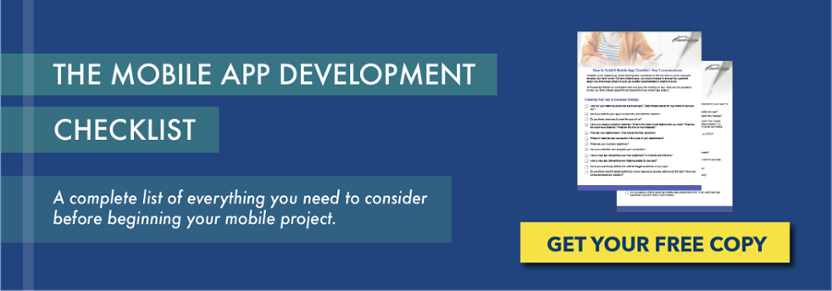In today’s dynamic market, mobile app development is proving to be a universally strategic branding decision for businesses, particularly looking to enhance their customer relationships. As a result, there is continued growth in companies investing in mobile app development, however, many companies are unable to plan and execute a successful mobile app launch. Being aware of, and mitigating the risks of these mobile app launch mistakes will lead to an app that can effectively build and retain customers well after an app has been launched.
Here is a list of 10 common, yet overlooked mobile app launch pitfalls and how to avoid them to increase the chances of your app succeeding:
1. Missed Pre-Launch Opportunities: Prior to the app launch, it’s easy to focus all of your resources on development alone. While it’s essential to build a high performing app, marketing efforts are just as important in order to ensure success once your app has hit the app stores. A common mistake is beginning marketing efforts too late, which amounts to less momentum upon release.
TIP: Promote your app on a variety of different channels, including social platforms, ads, websites, and even encourage industry influencers and reporters to talk about your app. Spread the word as much as you possibly can in order to gain the momentum needed for when your product hits the app stores.
2. Not Marketing Your App Early Enough: Your marketing efforts should never be an afterthought. They should start when you begin building your app.
TIP: Map out a timeline of execution leading up to your mobile app launch, and set your launch date far in advance. That way you will be able to foresee any contingencies that may occur.
3. Not Knowing Your Audience: Understanding the core set of users your app is built for is paramount to a successful mobile app launch. Although it can be easier to market broadly, a well-defined demographic will lead to higher conversion and retention rates. If you don’t know exactly what your audience wants, you won’t be able to understand their pain points and what they dislike about the apps that are already in the market.
TIP: Center your marketing plan around a few key questions: Who is your app built for? What is the problem your app is solving for your users? How is your app delivering value to users? Once to have the answers to these questions, you can center your marketing plan around those users.
4. Not Capitalizing on ASO: In order for an app to receive a high number of downloads, it has to stand out. You’ve invested a lot of time and money into your app, so how you do you make sure people see it? App Store Optimization (ASO) is a great way to boost your app’s visibility in the saturated app stores. Users should have an easy time discovering apps as it should be a quick and simple process, otherwise, your app can get lost amongst its competitors. Using ASO best practices it’s essential to successfully marketing an app.
TIP: Consider the following when submitting your app to its relevant app store:
Does Your App Have a Memorable Name? Your app should be named something that represents its purpose to potential users. This makes the name easier to remember and easier to search for in the app store.
Is The Description of Your App Optimized? A good description serves two essential purposes in successfully marketing an app. Firstly, it should act as an engaging hook to entice a consumer to download the app. Secondly, the keywords either inserted or extracted (depending on the relevant app store) are the words that consumers can search to find your app. Using words that represent your brand and app functionality will result in more click-throughs and higher app retention.
Is Your App’s Icon Enticing? The visual design of an icon represents your brand and the app’s functionality, so it’s important to select an icon that sets an appropriate first impression for potential customers.
Following ASO best practices allows you to capitalize on your app’s market potential.
Recommended Reading: What Do The App Store Updates Mean For Your App?
5. Underestimating the Value of Reviews & Ratings: Consumers are more likely to download an app if they can see its value. Strong ratings and reviews provide potential users with insight before they’ve even downloaded the app. Additionally, App store algorithms consider reviews and ratings as a part of their ranking system. In order to rank high, your app needs to have positive feedback from its users.
TIP: When was the last time you downloaded an app that had a one star rating on the app store? People need to be convinced that an app will add value that no other product in the market offers at the time. Reviews and ratings of an app matter both in terms of how the app store algorithm views it (the higher the rating and reviews, higher the ranking) and how it encourages a potential user to download the app. This is why n excellent user experience, the right ASO strategy, and choosing the correct submission platform are fundamental for the success of any app. If there is a negative comment, resolve the issue as soon as possible. It shows your customers that you are addressing their needs.
6. Neglecting Discovery Platforms: Discovery platforms, such as PreApps, AppGratis, and AppPicker will allow you to showcase your app to a targeted demographic through reviews, rates, and shares. This focused strategy will increase your conversion and retention rates which is the goal for any app.
TIP: Putting out your app on discovery platforms like PreApps, AppGratis, and AppPicker will help enhance your app’s conversion rate through features, reviews, and shares of your app to their user base. These app discovery platforms already have an engaged and targeted audience. At little to no cost, you can access these audiences, and achieve higher conversions for your app.
7. Not Releasing Updates: Apps that cause inconvenience or annoyance to customers are likely to be abandoned, leaving app publishers with low retention rates and negative brand perception. Bugs, lacking core functionality, or high battery usage are a few of the problems that motivate users to delete an app, in favor of a competitor’s product.
TIP: To avoid this, make sure to regularly update your app and address user concerns. One way to tackle this is by hiring a mobile app development firm to regularly release updates, resulting in an improved user experience.
With the updates of the redesigned App Store in iOS 11 announced at WWDC 2017, Apple will also be phasing out 32-bit app support this Fall when iOS 11 will be made available to the public. This means that many legacy apps will no longer function at all. The answer to why Apple is dropping 32-bit app support is quite simple: to improve the performance of the iPhone. Here’s how to convert your app to a 64-bit binary.
Recommended Reading: Why Is Apple Dropping 32-bit App Support And How Will It Impact Your App?
8. Launching An App That Already Exists: An in-depth scan of the market is essential prior to building an app, to ensure that your product will be discovered as one of a kind. Further, look into the patent and copyright policies that are relevant to your jurisdiction and product. Many companies fail to properly assess their full competitive set. If you don’t understand what your app’s strengths and weaknesses are, you won’t be prepared to successfully market your product.
TIP: You should be able to clearly identify and communicate your unique value proposition to set your company and product aside from the rest of the market. Competitive research will help reveal your competition’s strengths and weaknesses in order to define your own competitive advantage. Building a product that offers the same features as your competition’s won’t help you win over many users. A unique value proposition (UVP) is the first step you need to consider to optimize user loyalty and overall business success.
9. Not Validating Your App: An all-too-common mistakes that app developers make is not ensuring that their product idea is received well by stakeholders and users, increasing the chance of success of your product launch.
TIP: Consider developing a minimum viable product (MVP). An MVP is a minimal form of your complete product that is tested in the market. This allows you to learn how your users will react to your product, before you waste a lot of money and resources building something they don’t want or need. A Minimum Viable Product is a version of the product which includes only the features that allow you to release it to market, that solve a core problem for a set of users. The goal is to provide immediate value, quickly, while minimizing development costs.
10. Not Integrating Offline Marketing Efforts: Depending on the nature of your app, and its target demographic, you may find it beneficial to promote it through non-digital means.
TIP: Consider all relevant communication channels, not just digital, when developing your marketing plan.
Final Thoughts
An app’s ability to interact with its users can build and retain brand loyalty, making it a strategic branding decision for many companies. However, it’s important to be aware of and avoid potential pitfalls when launching a mobile app. A successful launch is paramount to enhancing your customer retention and improving customer acquisition long after the initial launch.









